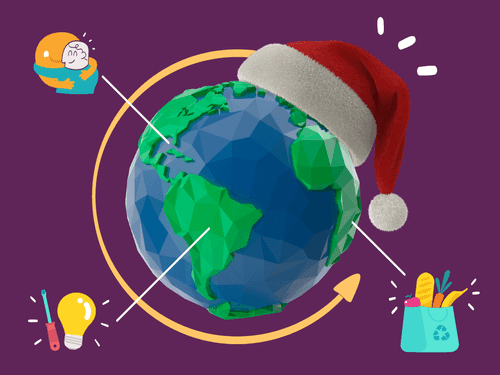
21/11/2022
Can you celebrate the end of the year in a circular manner?
Recycling is important, repurposingis necessary, but rethinking and reducing consumption is essential. Do you understand the difference? The circular economy’s proposal is to optimize the planet's resources and generate less and less waste, so if we buy less and make materials that are already in use circulate longer, fewer resources will be extracted to create new things and less waste will be produced.
What does this have to do with the holidays? Answer: A lot!
How many things do you usually buy at this time of year? There is Black Friday, promotions, Christmas gifts, secret Santa, souvenirs, giveaways for customers and employees, new clothes, furniture and electronics, renovations, suppers, decoration... The list is quite long, isn't it?
Mankind turns 91.4% of everything it produces into trash (according to the Circularity Gap Report). Throughout the year, 30% of all the waste generated in Brazil is made up of packaging items (data from the Akatu Institute). In 2021 alone, 17% of food ended up in the trash (UN data). Now, can you imagine how much all this increases towards the end of the year?
The more consumption, the more waste and the more greenhouse gases are generated, which are responsible for climate changes.
What if this Christmas we first ponder if we really need to consume all this?
"It’s the first Christmas in two years that we hope we can bring together everyone we love, even the farthest away. What if we focus on valuing peoples’ companies more than buying things? Or if we are going to really buy stuff, do so in a more informed and conscious way? One of the ways is to buy from companies that really take up socio-environmental commitments, such as, for example, investing or donating part of the profits of this period in activities that value circularity and sustainability", explains Professor Dr. Edson Grandisoli, Pedagogical Coordinator of the Circular Movement.
This change in positioning is not as difficult as it seems. Only two steps can make your holiday celebrations even more meaningful and significant, inspiring and even cost-effective: information and planning! Do you want to know how? We'll help you on this mission!
We've selected some conscious consumption practices to inspire your holiday season:
Giving gifts generating less waste
- There are gifts of a symbolic nature, such as donations and doing good deeds together.
- How about going for a ride together?
- Do you have a vegetable garden at home? How about giving a basket of vegetables or even seedlings?
- Do you have any fruit available? How about making homemade sweets and putting them in repurposed jars?
- Do you have a delicious cookie recipe? Children will love to receive a present in a beautiful packaging that you have recycled yourself.
Renovate the house without buying anything
- What if you fix what's broken instead of buying brand-new stuff?
- You can transform what you have at home by repaginating and renovating furniture and decoration. The internet offers plenty of inspirations! Meet the Raísa Guerra <inserir link em “Ráisa Guerra”: https://www.instagram.com/p/CgkmkNQjC1Z/>.
- How about donating or trading clothes at thrift shops and bazaars or even among friends? As well as objects and books on used book stores, for example.
- Instead of buying a plastic tree, how about decorating your own plants using the same lights and ornaments from previous years?
- Are you sick and tired of your Christmas ornaments? Have you ever considered trading them with relatives and close friends?
Eating and celebrating with less impact
- Planning how many people will eat and having a shopping list, you can avoid leftovers and waste.
- Use non-disposable plates and glasses.
- You can generate less packaging by buying the products in bulk.
- Bringing your own shopping bag generates less discarded plastic.
- What if we use seasonal fruit, national produce and local food?
- Buying from local producers and sellers gets even better!
- How about home cooking? Generates less packaging and transportation.
- What if we share food and make the joy of those who cannot have supper?
- Still, there'll be organic leftovers... so we can compost!
And at the time of purchase...
- How about giving priority to local, durable, reusable or recyclable products that have little or no packaging and come from socio-environmentally responsible companies?
- You can invest in local crafts, especially recycled or natural fragrance and refills, for example.
- Wrapping can be flaps of fabric you have at home, cloths that can be used for cleaning, recycled paper or repurposed giftwraps from other previous parties.
We spent the whole year inviting everyone to build together a world without waste. In this time of celebrating the achievements of the year, love and hope, let's not forget our purpose, shall we? It is worth having a Circular Christmas and maintaining this practice throughout the year!
What is the circular economy?
The Circular Economy proposes a new look at our way of producing, consuming, and disposing, in order to optimize the planet's resources and generate less and less waste. In other words, an alternative model to the Linear Economy - to extract, produce, use and discard - which has proved to be increasingly unsustainable throughout history. In the Circular Economy, the goal is to keep materials in circulation longer by reusing them until nothing becomes waste! For this model to become a reality, we all have a role to play. It is a true collaborative circle, which feeds itself, and helps to regenerate the planet and our relations.
Learn about Circular Economy
If you are interested in learning more about this topic, visit Circular Academy, the first free Latin American course on circular economy aimed at general audiences. All of us, in partnership and collaboration, can make a difference in building a more circular planet.

